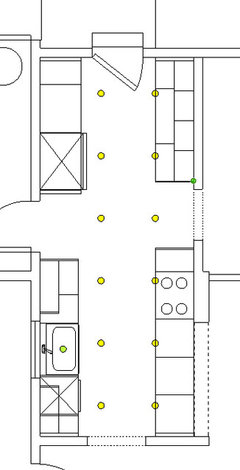

#6 recessed lighting layout how to#
When planning how to place recessed lighting for even light distribution, a general rule of thumb is to have at least one light for every 25 square feet of living space. Let’s say that you want to use recessed lighting for general or ambient lighting in a room that has even light distribution. Calculate the Number of Recessed Lights Needed With that in mind, if you want to light a whole basement with lots of light, the light choice will be necessary.

Each dimmer will have a maximum watt capacity.įor small areas, there should be nothing to worry about.

It is always good to use an LED dimmer with all recessed lighting applications. Room sizeĪnother thing to consider is how big your room is, how many lights you need, and how many watts your switch or dimmer can handle. Large 5-6 inch recessed lighting fixtures that are very bright can be spaced apart and used less if they are huge and colorful. Use more lights and space them closer together if you plan to use smaller lights that have an ideal level of brightness. The choice of which recessed lights you want to use will play a small role in arranging the lighting in your room. This can help you by letting you sketch several different patterns without having to measure your room each time. During these planning stages, being precise is very important. It’s essential to spend a lot of time when you sketch your room and its main things. Then, put a scale on your graph paper to see how big things are. Make sure to use graph paper and your measuring tape. This sketch will be your rough plan, this will help you sketch more accurately. In the next step, you’ll sketch out the room and its rough layout on paper to figure out what you want the recessed lights to do. For example, in your kitchen, you might want to put recessed lights under your base cabinets or above your stove hood. Task lights are used in places like the work area so that you don’t have to strain your eyes. For instance, you might want to use accent lights to light up that beautiful piece of abstract expressionist art you recently bought with a wall-wash of light. If you want to make a specific thing or wall stand out, you can use accent lighting. As a typical rule, you start with a light in the center of the room that you can then use to evenly distribute your lighting all over the room. It should give off a soft light, even a glow that isn’t too bright. In general, there are three main types of lighting goals: Ambient LightingĪmbient lighting is used to light up your whole room. In general, the main goal of your lighting will help you decide what kind of layout and calculations you will use. Or maybe you want to add lighting to the entire room to make it look bright and warm.

For example, you will need to decide if you’re going to make specific items in the room the focal point of the room. If you’re ready to move into a new home but aren’t willing to compromise on the amenities you want, Champion Homes can help.The first thing is figuring out what you want your recessed lighting to do before you start. You can also find stylish features such as tray ceilings, recessed lighting, custom cabinet applications, large family rooms with entertainment centers and more. Like site-built homes, our manufactured homes and modular homes offer plenty of floor plans and amenities. Modern kitchens with stainless steel appliances and perhaps spacious bedrooms with walk-in closets? Those, too. Interested in vaulted ceilings? We offer them. Finally, all of our manufactured homes and modular homes undergo more than 35 quality inspections throughout the construction process to ensure they meet our high standards. Our technicians, craftsmen and assemblers are well trained and professionally supervised, resulting in built-in excellence. They’re built in a controlled factory environment, which means every part of the home – from the front door to the bathroom sink – is protected from weather-related damage, vandalism and other hazards. As one of the largest mobile home builders in the country, we’re able to negotiate low prices on building materials, including interior features and appliances, resulting in lower costs for our homebuyers.Īfter more than six decades serving homebuyers, we’ve developed advanced engineering and construction methods to ensure energy efficient, quality-built manufactured homes and modular homes. Champion has a long history of providing affordable alternatives to site-built and other types of housing.


 0 kommentar(er)
0 kommentar(er)
